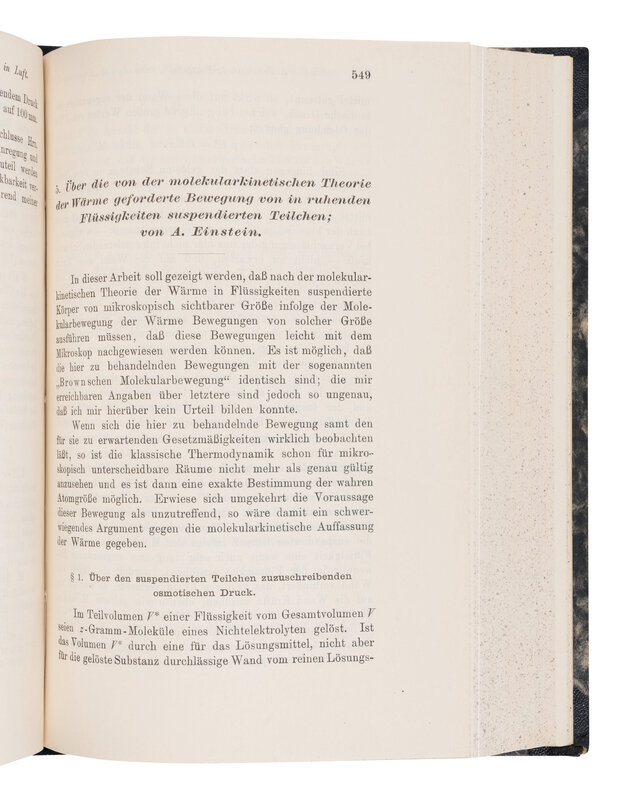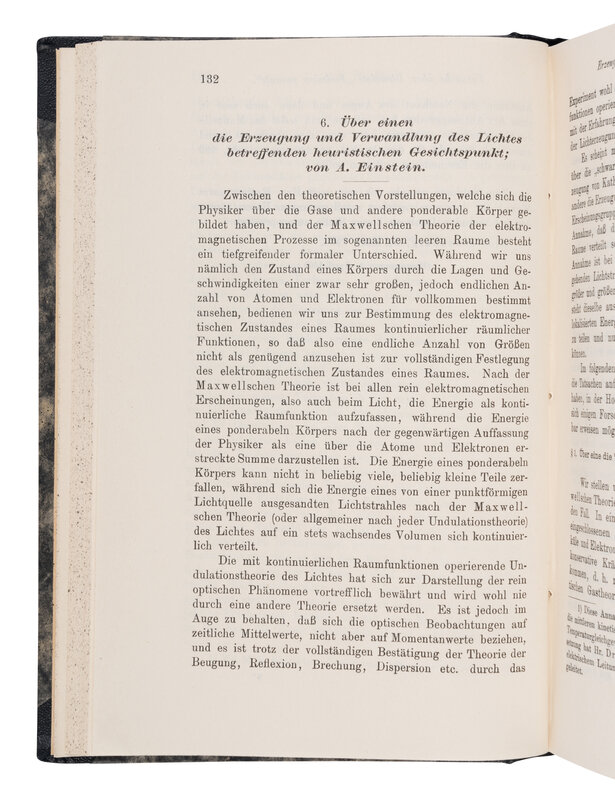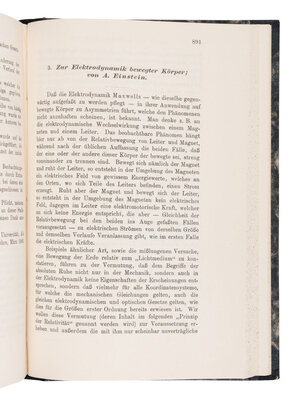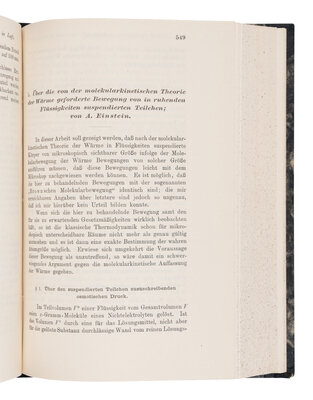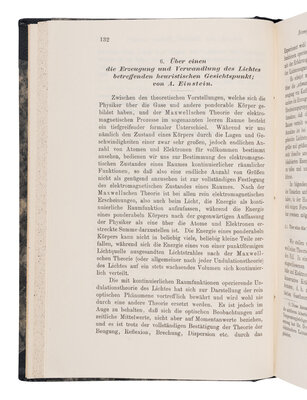Condition Report
Contact Information
Lot 86
EINSTEIN. THE THREE PARADIGM-SHATTERING PAPERS OF EINSTEIN’S “WONDER YEAR.” 1905. On relativity, photons & the atom.
Sale 2065 - Fine Printed Books and Manuscripts, Including Americana
Nov 14, 2024
9:00AM CT
Live / Chicago
Own a similar item?
Estimate
$10,000 -
15,000
Price Realized
$20,320
Sold prices are inclusive of Buyer’s Premium
Lot Description
EINSTEIN, Albert (1879-1955). "Uber einen die Erzeugung und Verwandlung des Lichtes betreffenden heuristischen Gesichtspunkt." -- "Uber die von der molekularkinetischen Theorie der Wärme geforderte Bewegung von in ruhenden Flüssig kieten suspendierten Teilchen." -- "Zur Elektrodynamik bewegter Körper." In: Annalen der Physik... fourth series, vol. 17, pp.132-148, pp.549-560, pp.891-921. Leipzig: Johann Ambrosius Barth, 1905.
8vo. Later half black cloth, paper spine label, speckled edges. Provenance: Christian Heuer, book collector (bookplate).
FIRST EDITIONS, journal issues, of three important early papers by Einstein: ON PHOTONS, THE ATOM, AND SPECIAL RELATIVITY–THE THREE PARADIGM-SHATTERING PAPERS OF EINSTEIN’S “WONDER YEAR.”
In his first paper on the photon, "Uber einen die Erzeugung und Verwandlung des Lichtes betreffenden heuristischen Gesichtspunkt" (pp.132-148), "Einstein suggested that light be considered a collection of independent particles of energy, which he called ‘light quanta.’ Such a hypothesis, he argued, would provide an answer to the problem of black-body radiation where classical theories had failed… For this paper, and his paper on the photoelectric effect (1906), Einstein was awarded the Nobel Prize in Physics in 1921” (Norman).
Einstein's second paper on the Atom "Uber die von der molekularkinetischen Theorie der Warme geforderte Bewegung von in ruhenden Flussigkeiten suspendierten Teilchen" (pp.549-560), provided the first statistical physics analysis of Brownian motion and proved the reality of molecules and their motions. (The French physicist Jean Perrin subsequently used Einstein's results to experimentally determine the mass, and the dimensions, of atoms, thereby conclusively verifying the atomic theory propounded by John Dalton.) Given the widespread implications and applications of
atomic reality for all levels of material existence, this second paper is understandably Einstein’s most frequently cited work. “[This] paper… helped convince skeptics of the physical reality of molecules” (ibid).
Einstein's third, arguably his most important, paper (pp.891-921) "Zur Elektrodynamik bewegter Körper" ("On Electrodynamics of Moving Bodies"), is Einstein's first published work on Special Relativity, and is arguably the one Einstein paper that has most singularly gripped the popular imagination. Seeking to resolve the seeming incompatibility of Maxwell’s electromagnetic theory and Newtonian mechanics, Einstein here reformulates the laws of mechanics to handle situations dealing with velocities close to light speed. A wide range of common-sense-challenging notions arise from this relativistic reformulation – from length contraction to time dilation (and the famous “twin paradox”, involving the space-traveler moving at light speed who returns to earth as a person younger than when he left) – and very importantly including the equivalence of energy and mass, immortalized in the equation E=mc2. “The electro-dynamics of moving bodies’ was Einstein’s first paper on the subject of special relativity. Two revolutionary conclusions were reached in this paper: first, that all motion was relative to the inertial system in which it was measured; and second, that matter and energy are equivalent. The presentation of these theories, which were proved some years later, constituted nothing less than a radical reinterpretation of the universe, dethroning the Newtonian view which had ruled for over two centuries” (ibid).
Heralding as it does the emergence of Einstein as the greatest physicist of the 20th century, this volume has justly been called (by Max Born) “One of the most remarkable volumes in the whole of scientific literature”. Boni, Russ & Laurence 7, 8, 9; Dibner, Heralds of Science 167; Norman 689, 690, 691A; Weil 6, 8, 9.

